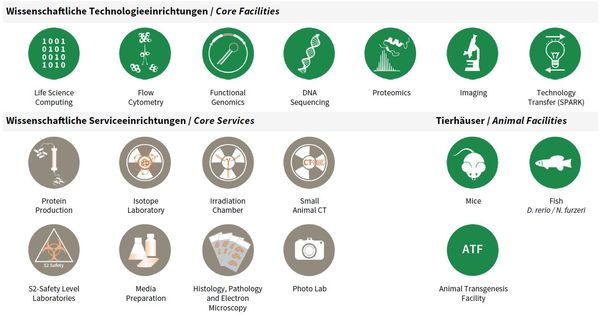Core Facilites and Core Services
At the beginning of 2016, a “core” structure was put into effect that organized facility and service units as independent organizational entities from FLI’s research groups. A number of technology platforms (e.g. sequencing, mass spectrometry) grew out of individual methodological requirements for single research groups in the last years but developed into semiautonomous substructures. As consequence of re-focused research activities and the concomitant advent of new research groups at FLI, those units increasingly had to serve many FLI groups and collaborative research efforts in the Jena research area.
To accommodate this development and to increase efficiency as well as transparency for users, facility personnel and for administrative processes, it came natural to re-organize such activities into independent units as “FLI Core Facilities and Services” and to phase out infrastructures considered non-essential for FLI’s research focus (X-ray crystallography and NMR spectroscopy).
FLI’s Core Facilities (CF) are managed by a CF Manager and are each scientifically guided in their activities and development by an FLI Group Leader, as Scientific Supervisor. The animal facilities comprising fish, mouse and transgenesis are run separately, as they involve a more complex organizational structure. Basic Core Services (CS) are directly led by the Head of Core (HC), who in turn is supported by individual CS Managers.
All facilities and services, including animal facilities, have a valuable contribution to FLI’s research articles; e.g. from 2016–2018, to 54% of all peer reviewed research publications.
Overview Core Facilities and Core Services at FLI.
Publications
(since 2016)
2018
- Deletion of Menin in craniofacial osteogenic cells in mice elicits development of mandibular ossifying fibroma.
Lee S, Liu P, Teinturier R, Jakob J, Tschaffon M, Tasdogan A, Wittig R, Hoeller S, Baumhoer D, Frappart L, Vettorazzi S, Bertolino P, Zhang C, Tuckermann J
Oncogene 2018, 37(5), 616-26 - Conformational Plasticity in Broadly Neutralizing HIV-1 Antibodies Triggers Polyreactivity.
Prigent J, Jarossay A, Planchais C, Eden C, Dufloo J, Kök A, Lorin V, Vratskikh O, Couderc T, Bruel T, Schwartz O, Seaman MS, Ohlenschläger** O, Dimitrov** JD, Mouquet** H
Cell Rep 2018, 23(9), 2568-81 ** co-corresponding authors - Impairing L-Threonine Catabolism Promotes Healthspan through Methylglyoxal-Mediated Proteohormesis.
Ravichandran M, Priebe S, Grigolon G, Rozanov L, Groth M, Laube B, Guthke R, Platzer M, Zarse K, Ristow M
Cell Metab 2018, 27(4), 914-25 - Higher gene expression stability during aging in long-lived giant mole-rats than in short-lived rats.
Sahm A, Bens M, Henning Y, Vole C, Groth M, Schwab M, Hoffmann S, Platzer* M, Szafranski* K, Dammann* P
Aging (Albany NY) 2018, 10(12), 3938-56 * equal contribution - Long-lived rodents reveal signatures of positive selection in genes associated with lifespan.
Sahm A, Bens M, Szafranski K, Holtze S, Groth M, Görlach M, Calkhoven C, Müller C, Schwab M, Kraus J, Kestler HA, Cellerino A, Burda H, Hildebrandt T, Dammann P, Platzer M
PLoS Genet 2018, 14(3), e1007272 - Aspergillus fumigatus conidial metalloprotease Mep1p cleaves host complement proteins.
Shende R, Wong SSW, Rapole S, Beau R, Ibrahim-Granet O, Monod M, Gührs KH, Pal JK, Latgé JP, Madan T, Aimanianda V, Sahu A
J Biol Chem 2018, 293(40), 15538-55 - The ATR-Activation Domain of TopBP1 Is Required for the Suppression of Origin Firing during the S Phase.
Sokka* M, Koalick* D, Hemmerich P, Syväoja JE, Pospiech H
Int J Mol Sci 2018, 19(8) * equal contribution - A subset of chemosensory genes differs between two populations of a specialized leaf beetle after host plant shift.
Wang D, Pentzold S, Kunert M, Groth M, Brandt W, Pasteels JM, Boland W, Burse A
Ecol Evol 2018, 8(16), 8055-75 - A p300 and SIRT1 Regulated Acetylation Switch of C/EBPα Controls Mitochondrial Function.
Zaini MA, Müller C, de Jong TV, Ackermann T, Hartleben G, Kortman G, Gührs KH, Fusetti F, Krämer OH, Guryev V, Calkhoven CF
Cell Rep 2018, 22(2), 497-511
2017
- Tissue-, sex- and age-specific DNA methylation of rat glucocorticoid receptor gene promoter and insulin like growth factor 2 imprinting control region.
Agba OB, Lausser L, Huse K, Bergmeier C, Jahn N, Groth M, Bens M, Sahm A, Gall M, Witte OW, Kestler HA, Schwab M, Platzer M
Physiol Genomics 2017, 49(11), 690-702 APSselect for distinction in scholarship in the Physiological Genomics









